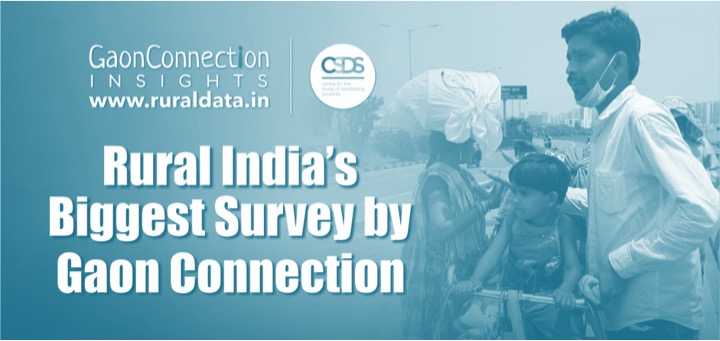Gaon Connection, India’s largest rural media platform conducted a national survey on status of rural India during Covid-19 . The study documented the untold miseries rural citizens faced during the lockdown. These pains ranged from mounting debts, increasing hunger, inability to access healthcare to complete loss of livelihoods.
The survey was based on face-to-face detailed interviews with 25,300 respondents. It was carried out in 179 districts across 20 states and three Union Territories. The survey was designed and data analysed by the New Delhi-based Centre for Study of Developing Societies (Lokniti-CSDS).
These survey findings have been put together in the form of a report – The Rural Report – by Gaon Connection. This exhaustive 200-page report is the first set of national insights documenting the post-COVID-19 impact on rural India . The report is divided into different themes that include the impact on farmers, financial stress and debt. Other areas covered are livelihoods and MGNREGA, pregnant women’s health, hunger, future plans of rural citizens, etc.
The key findings of the Gaon Connection Survey
— More than 68 per cent rural Indians faced “high” to “very high” monetary difficulty during the lockdown.
— About 23 per cent rural Indians borrowed money during the lockdown. 8 per cent sold a valuable possession (phone, watch etc). 7 per cent mortgaged jewellery, and 5% sold or mortgaged land.
— 78 per cent respondents saw their work coming to a “complete standstill”. Or “a standstill to a large extent” during the lockdown.
— Skilled workers and manual (unskilled) labourers were the hardest hit. Work shut down completely for 60 per cent skilled workers and 64 per cent manual labourers
Status of MGNREGA payments
— Only 20 per cent respondents said they got work under MGNREGA in the lockdown. Chhattisgarh reported the highest percentage of such households at 70 per cent. It was followed by Uttarakhand (65 per cent) and Rajasthan (59 per cent). Gujarat and UTs of Jammu & Kashmir-Ladakh reported the lowest work under MGNREGA at 2 per cent and 4 per cent, respectively.
— 23 per cent migrant workers returned home walking during the lockdown. Over 33 per cent migrant workers said they want to go back to the cities to work
— 42 per cent households with pregnant women said these women did not get pregnancy check-ups and vaccination during the lockdown. The lowest percentages were in West Bengal (29 per cent) and Odisha (33 per cent).
Farmer’s difficulties
— 56 per cent dairy and poultry farmers said they faced difficulty in taking their produce to the buyers. 35 per cent said they did not get the right price for their produce.
— More than half the farmers managed to harvest their crops in time in the lockdown, but only one fourth could sell them on time
— 71 per cent ration card-owning households said they received wheat or rice from the government during the lockdown. Of the 17 per cent citizens who do not own ration cards, only 27 per cent said they received wheat or rice from the government.
— 71 per cent surveyed households reported a drop in total monthly household income during the lockdown months compared to pre-lockdown months
— The poor were the hardest hit — 75 per cent poor families and 74 per cent lower-class households suffered a fall in income during the lockdown.
— 38 per cent of the rural households reported having gone without necessary medicine or medical treatment often or sometimes during the lockdown. In Assam, 87 per cent rural households said they did not receive the required medical treatment followed by 66 per cent in Arunachal Pradesh.



























